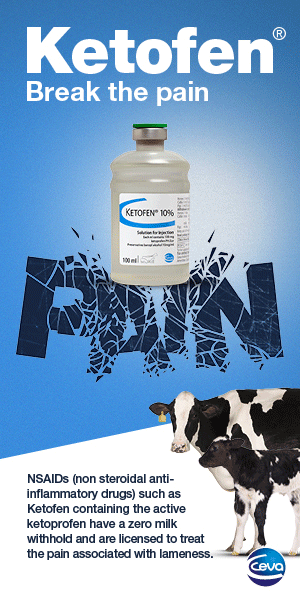Sole ulcers affect approximately 6 dairy cows per 100 annually in the UK, but the range on UK farms is wide (0-54.8 cases per 100 cows per year). Sole ulcers can be a major cost to the dairy business, with the average case costing an estimated £324.17.
Compared with the best UK farms that never experience sole ulcers, the annual cost to the average farm is approximately £2000 per 100 cows, rising to approximately £18,000 per 100 cows per year for the worst performing farms. The major costs are mostly hidden as early culling, reduced fertility and a large 'ceiling effect' on milk yield (Table 1 below).

Fig 1 (right) : A sole ulcer (red arrow) - classic position and appearance. The affected area in the picture is exposed quick which is usually sensitive and bleeds easily. Somwetimes 'proud flesh' develops which is more ragged and insensitive.
Table 1: Production and welfare statistics regarding sole ulcers
|
Measure of production and welfare |
Impact of sole ulcer compared with unaffected cows |
|
Reduced milk yield * |
570kg |
|
Increased culling |
Culling 2.7 times more likely if a cow is diagnosed with a sole ulcer in the first 4 months of lactation |
|
Infertility
|
11 days longer 40 day extension 0.72 extra inseminations per case |
*Higher yielding cows are more prone, so the milk loss has to be estimated using predicted milk yield
However, it is perhaps the welfare cost which is of greatest concern, as sole ulcers result in chronic cases of lameness that require repeated treatments and in many cases lead to other secondary problems such as deep digital sepsis. Sole ulcers tend to first develop following calving, appearing 4-5 months into lactation when cows are under the greatest production strain. Initial damage is often started in the first few weeks of the first calving, going on to cause repeat and persistent problems in subsequent lactations.
Causes of sole ulcer
Sole ulcers are thought to be caused by pinching and concussive trauma and pinching around a hooked process on the pedal bone where the flexor tendon attaches, producing inflammation, triggered by sinking of the pedal bone and other factors that occur around calving. This most commonly occurs in the outer claw of the hind feet. In the front feet, the inner claws are most commonly affected.
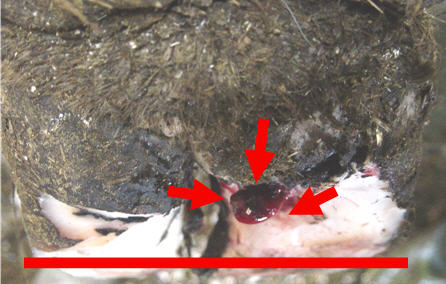
Fig 2

Figure 2a - A diagrammatical representation of the cross-section of a claw to illustrate the process of sole ulcer development. At calving the laminar attachment weakens, allowing the pedal bone to sink and the quick next to the sole horn to pinch and bruise. Pinching is worst where the bony lever for the flexor tendon attachment occurs and lack of digital cushion (heifers and thin cows) increases this. Inflammation initiated around or soon after calving, prevents horn growth at the pinch point, and persists until the pressure or inflammation is relieved. The swelling due to inflammation in a closed claw space reduces blood supply, increasing inflammation further and maintaining the cycle.
There appears to be no single factor contributing to this process. Factors can include:
-
Calving - weakening of laminae in the claw allows pedal bone sinking. Once sunk the pedal bone can never return to the position found prior to first calving.
-
Body condition score loss and thin digital cushion (fat pad) due to fat loss and under-development particularly in heifers. Exercise and expsoure to concrete will promote fat pad development.
-
Shallow foot angle and claw overgrowth - increasing overloading and pinching in the heel and typical site for sole ulcers.
-
Standing on concrete - long standing times on concrete in freshly calved cows produces the initial bruising. Futhermore, if prolonged standing on concrete continues it prevents recovery with exposed and infected quick 2-4 months later. Prolonged standing times may be due to long turnaround times at milking or penning at other times (eg milking, AI) or voluntary standing while cows wait to lie down or feed.
-
Slurry contaminated conditions - unclear mechanism; either softening and eroding the horn, or reducing the claw horn wear, leading to poor foot angles.
There appears to be no evidence that rough tracks contribute to sole ulcer, although the stones and uneven surfaces associated with rough tracks will highlight those cows lame with sole ulcers.

Figure 2b - Shallow foot angle or claw horn overgrowth further increases the overloading and pinching.
Treatment
Successful treatment of sole ulcers involves steps to relieve the pinching and inflammation, which is most effectively achieved by:
- Dutch 5 step claw trimming - steps 1-3 correct claw shape and confirm the sole ulcer.
- Often the lesion will be covered by overgrown and diseased horn, the lesion becoming visible after stage 3. (Fig 2)
- Step 4 relieves weight off the ulcerated claw. This is most effectively done using a block.(Fig 4) but trimming down back 2/3 of heel on the affected claw will add a height difference.
- Step 5 involves trimming the loose collar of horn from around the neck of the sole ulcer and creating some thinning sole around the base of the ulcer so the sole is flexible(red arrows) (Fig 2, Figs 3a and 3b).
- Providing soft surfaces under-foot (pasture, straw bedded yard)
- Encouraging cows to rest (free access to comfortable lying area and plenty of feed space).
- Anti-inflammatory drugs
If caught early, claw trimming can be sufficient to prevent an ulcer at a brusing stage. However, in many cases the under-run horn reaches the sole surface allowing infection to track in to the quick. In these cases, the exposed quick becomes infected as well as inflamed, and a prolapse of the swollen quick out the horn may occur which will take longer to recover. Most prolapses are swollen quick and should not be amputated as it forms a barrier to infection tracking to the joint. However, sometimes excessive 'proud flesh' is produced which may need addressing.

Fig 3a: schematic cross-section through the prolapsed quick before final trimming.

Fig 3b: Schematic cross-section through the prolapsed quick showing the ideal trim of horn around a sole ulcer. Sharp knives are essentila for this task. Unles non-painful, ragged proud felsh the prolapse should be left to shrink rather than be amputated.
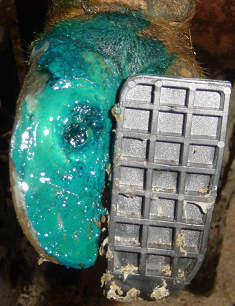
Fig 4: Weight may be taken off painful claw by glueing shoe or block to sound claw.
Recovery will be influenced by:
-
Avoiding further damage to the quick. Care with the knife and knife hygiene is essential and avoiding use of caustic chemicals like copper sulphate which can inhibit healing. The prolapsed 'mushroom' should not be intentionally cut off. Rough stony tracks will not help recovery.
-
Hygiene at trimming and in the housing. If the quick can be kept clean and disinfected then healing should be rapid. Digital dermatitis will infect sole ulcers making a severe lesions
-
Antibacterial gel/spray will speed up the recovery of infected quick. If any swelling is detected above the claw then injectable antibiotics (in addition to anti-inflammatory) drugs should be considered. Always consult your vet on this approach.
-
Bandages should be avoided in most situations as they retain slurry and are likely to increase weight-bearing on the affected claw
Prevention
Good nutrition is fundamentally important for the general health and productivity of dairy cows. However, there are no proven direct links with acidosis or laminitis. Therefore, methods for reducing sole ulcers by altering diets alone, should focus on minimising body condition score loss. Other preventative measures include reducing standing on concrete, particularly at calving. Where sole ulcers are a herd problem, the following ways to reduce standing times should be considered (in approximate order of importance):
-
Comfort groups, (e.g. deep bed cubicles or loose yards) for 4 weeks before calving and 4-8 weeks after calving (Fig 5). Most farms have some scope to improve cow lying comfort in the freshly calved period for at least 1-2 weeks after calving, if not for 8 weeks.
-
Reduce enforced standing times at milking by using the following:
-
Small fresh cow or fresh heifer groups to reduce standing times at milking, to target low stocking rates and to target improved lying comfort for the high risk groups of animals.
-
Splitting the herd so that cows stand for no longer than 1 hour before each milking. Ideally groups should be socially stable.
-
Don't shut cows off beds after milking. Provide immediate access to a clean, dry and hygienic lying area (combined with feed straight after milking. Some cows with bruised feet may need to lie down straight away to prevent sole ulcers. Although returning to bed straight after milking may be a risk factor for mastitis, it is mitigated that if cows have access to plenty of feed as they exit the parlour. If environmental masitits is a problem then tackling bed hygiene is priority. Shutting cows off beds may be stressful and thereby contributing to problems other than foot lesions.
-
-
Reduce enforced standing times at times other than milking. Cows are inevitably penned up potentially away from food, water and lying area for foot trimming, AI, mucking out or the vet routine. This time should be minimised. Whenever possible, provide lying space, feed and water in holding areas.
-
Increase lying times. Lying surface, cubicle dimensions and stocking rates should all be considered.
-
Routine claw trimming using the Dutch 5 step method (see previous module).
-
Cubicle training of heifers during the bulling or early in-calf period. 'Tying-' of heifers or cows in cubicles must be avoided.
-
Improved walkways and cow flow to reduce cow waiting times.
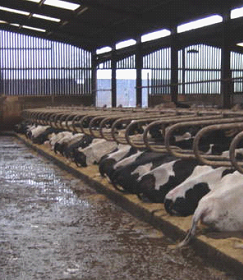
Fig 5: When feasible provide straw yards for 4 weeks before calving and 8 weeks after calving.
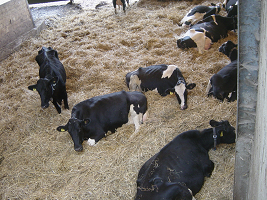
Fig 6: Lying surface, cubicle dimensions and stocking rates should all be considered.
Sole ulcers take several weeks to develop. Once pedal bone sinking and bruising of the quick has occurred, sole ulcers will tend to recur, usually 4-5 months into each subsequent lactation. This places great importance on strategies to prevent new sole ulcers from developing. Control strategies should be monitored using each new crop of first-calved heifers, calculating the percentage of first-calved heifers recorded with sole ulcers.
